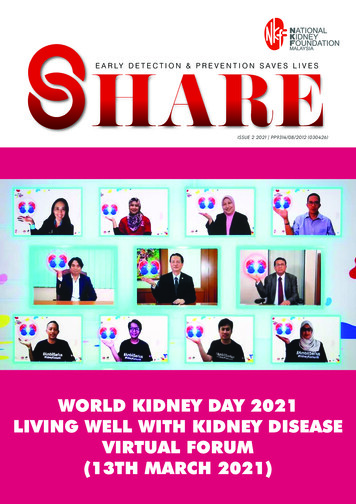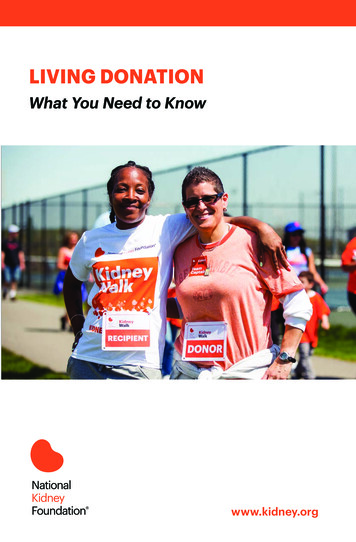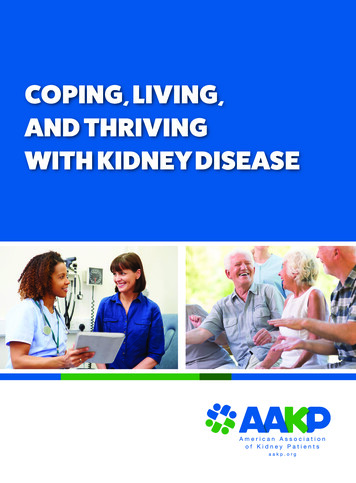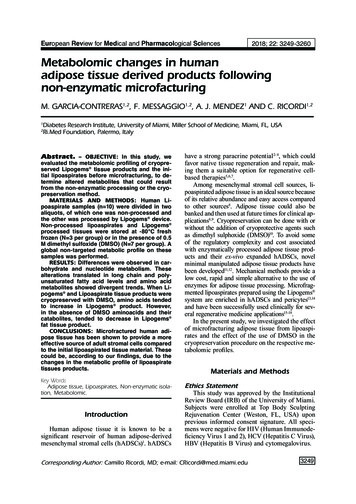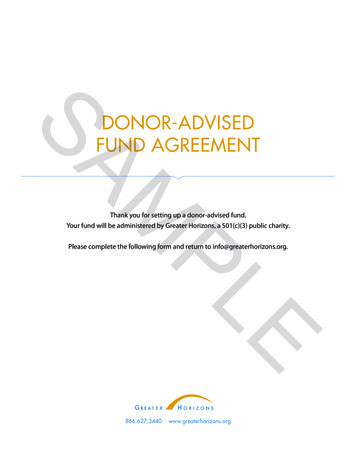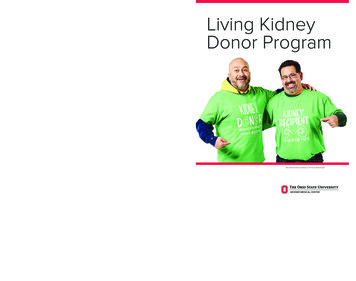
Transcription
For more information about living kidney donation, please call 800-293-8965, option 3.Living KidneyDonor ProgramLiving KidneyDonor ProgramThe Ohio State University Wexner Medical CenterComprehensive Transplant Center300 W. 10th Ave., 11th floorColumbus, OH 43210wexnermedical.osu.edu/KidneyDonorRaul (left) donated a kidney to his friend Albert (right)TXLKD 19223263
IntroductionMegan received a kidney from her husband Jake1 - PROGRAM OVERVIEWLiving Kidney Donor Program
Why ChoLivingAbout The Ohio State UniversityWexner Medical CenterRecognized by U.S. News & World Report magazine as a top hospitalcaring for patients with kidney disease, The Ohio State UniversityWexner Medical Center’s transplant program is one of the largest inthe country and among the busiest kidney transplant programs in theregion. Ohio State’s Comprehensive Transplant Center is the onlyadult transplant center in central Ohio, performing more than 10,000transplants since it was established in 1967. We perform approximately200 kidney transplants a year.2 LIVING DONOR PROGRAMSJames (left) received a kidney fromfellow church member Craig (right)
oose to be aKidney Donor?Patients with end-stage renal disease have three options for treatment: dialysis, a kidney transplant from adeceased donor or a kidney transplant from a living donor.Dialysis is only a temporary solution. While a patient can remain on dialysis for many years, it is not a cure forkidney disease. It is also time-consuming, with treatment schedules as frequent as three times each week forfour hours each session.Transplantation is a preferred alternative, but the demand for donated organs is greater than the numberof available organs, and demand is steadily increasing. United Network for Organ Sharing (UNOS), theorganization responsible for allocating deceased donor organs for transplant, reports there are more than94,000 candidates waiting for a kidney transplant. In 2018, only 14,725 kidneys were transplanted fromdeceased donors.The best option for a patient waiting for a kidney is to receive one from a living donor. Wait times for patientswith living donors are reduced from years to months, and transplant recipients have better outcomes withkidneys from living donors. According to the National Kidney Registry, kidneys transplanted from living donorsmay last nearly twice as long as kidneys from deceased donors.At any given time, about 500 patients in Ohio State’s transplant program are awaiting a kidney transplant –many whose lives could be changed by a living donor.Patients with a living donor can receive a transplant more quickly, potentially avoidingdialysis. The wait for a kidney from a deceased donor can be many years.About half of the transplants performed at Ohio State use kidneys from livedonors. Often these donors are family members, but a growingnumber are friends or co-workers. There are also peoplewho choose to donate a kidney without having a specificrecipient in mind. These extraordinary people are callednon-directed or altruistic donors.Howard received a kidney from his wife CatherineLIVING DONOR PROGRAMS 3
QualificationsFor Living DonorsTo qualify as a living donor, an individual should be in good overall physical and mental health and free fromuncontrolled high blood pressure, diabetes, cancer, HIV/AIDS, hepatitis and organ disease.Individuals considered for living donation are usually between 18-70 years of age. Gender and race are notfactors in determining a successful match.Living donor candidates must take a blood test to determine blood type compatibility with the recipient.DONORS WITH BLOOD TYPECAN DONATE TO PATIENTS WITH BLOOD TYPEAA and ABBB and ABABABOA, B, AB and OIf the donor and recipient have compatible blood types, the donor undergoes a medical history review and acomplete physical examination, in addition to tests to ensure compatibility. The donor and recipient may alsohave to complete a psychological evaluation. It is important to note that even if a donor’s blood type is notcompatible with the recipient’s, there is still the option to be an indirect donor for your recipient. Pleasereview the information on Kidney Paired Donation on page 6.The decision to become a living donor is a voluntary one, and the donor may change his or her mind at anytime during the process. The donor’s decision and reasons are kept confidential.Education is the most important component in the decision to become a living kidney donor.If you are considering donation, you can speak with a living donor nurse coordinator at theOhio State Comprehensive Transplant Center by calling 800-293-8965.Donors and recipients in 5-way kidney paired donationchain transplanted on Valentine’s Day, 20174 LIVING DONOR PROGRAMS
Evaluation Process –What to ExpectOhio State’s Pre-Transplant Office will schedule an evaluation appointment with you that will include medicaltesting, an education session, evaluation by a surgeon and a nephrologist (kidney doctor) and a conversationwith a donor advocate. Additional testing will also be scheduled. Here’s what you can expect during yourevaluation process: You will need to provide a copy of your blood type or have blood drawn to confirm blood type(the Pre-Transplant Office will provide an order for blood draw) 24-hour blood pressure monitoring Women donors will need to provide a copy of their last Pap test result, breast exam and mammogramreport. A Release of Information form is included in this packet. Please sign the form and forward it toyour doctor’s office. If your Pap test or mammogram is more than a year old, you should schedule anappointment for new exams You may need to complete a Glucose Tolerance Test (GTT) if requested by the Pre-Transplant Office 24-hour urine collection (this will be performed twice) Chest X-ray and EKG (tests to determine heart and lung health) CT angiogram of kidneys (an X-ray test to evaluate the kidneys and blood vessels) Full day at Transplant Clinic for education, meeting with transplant coordinator, psychosocial evaluation,surgical and medical evaluations, completion of tests Any additional testing as needed Final pre-donation evaluation studies (done seven to ten days before surgery)LIVING DONOR PROGRAMS 5
Kidney Paired DonationSometimes, a person may agree to donate a kidney to a recipient, but his or her blood or tissue type doesnot match their recipient. Ohio State’s Comprehensive Transplant Center can help match such a donor/recipient pair with another donor/recipient pair through a process called Kidney Paired Donation.For example, if the recipient from one pair is a match with the donor from another pair and vice versa, theTransplant Center can arrange the exchange through two simultaneous transplants. This allows the tworecipients to receive organs from two people who were willing to donate, even though the original pairingswere incompatible or mismatched.MotherDonor #1SonRecipient #1HusbandDonor #2In a paired donation, anincompatible donor/recipientpair is matched with anotherincompatible donor/recipientpair for an exchange. Eachdonor gives a kidney to theother person’s intendedrecipient.WifeRecipient #2Both donor and recipient candidates are carefully evaluated and tested medically and psychosocially toensure that the benefits outweigh the risks. It is important for both surgeries to be scheduled for the sametime, in case either donor changes their mind at the time of surgery.Kidney Paired Donation can also involve multiple donors and recipients. In September 2011, Ohio StateWexner Medical Center achieved national recognition with a six-way kidney paired transplant, coordinatingthe in-house transplantation of six kidneys in a domino-effect surgical process.Since 2011, we’ve completed two additional six-way kidney chains and several four- and five-way chains.With more than 94,000 Americans currently waiting for a kidney in the U.S., these types of paired donationscan have a positive impact on the kidney transplant wait list.6 LIVING DONOR PROGRAMS
Non-Directed Living DonationA non-directed living donor, or altruistic donor, is someone who offers to donate a kidney to any recipientcurrently on the deceased donor waiting list. Non-directed donors must satisfy the same medical, psychosocial and ethical criteria used in the selectionof all living donors, as well as any recommended psychiatric criteria. Non-directed donors must be 21 years or older. The transplant team will provide opportunities for discussion and education at all stages of the donorevaluation. Non-directed donors will be reassured of the ability to withdraw their decision to donate atany time. The transplant team will assess the donor and the recipient’s position regarding anonymity. In all cases,anonymity between the donor and the recipient will be maintained until the transplant is complete. Thetransplant team will facilitate correspondence between the donor and the recipient post-transplant, only ifagreed-upon by both parties.Evaluation Process: Non-directed living donors will receive a medical evaluation at Ohio State ComprehensiveTransplant Center. A preliminary donor evaluation is conducted after the individual’s first contact with our transplant teamto indicate his or her interest in pursuing organ donation. Potential donors are sent a living donorinformational packet and asked to complete and submit a potential donor screening form. A full donor evaluation is initiated after candidates submit the potential donor screening form, if the patientmeets general selection criteria. This process involves gathering additional information and reaffirming thepotential donor’s interest and intent in pursuing donation. Education on all aspects of donation is providedto the potential donor. Non-directed donors will undergo the same evaluation process as directed donors, including evaluationby a living donor coordinator, transplant coordinator, social worker, psychologist, transplant nephrologist(kidney doctor), transplant surgeon and living donor advocate.Non-directed donors are often viewed as Good Samaritans who have the opportunityto spur multiple transplants by starting a transplant chain in our Kidney PairedDonation Program. In September 2011, a 58-year-old mother of four from centralOhio, who had been inspired by the strength of those she’d seen strugglewith illness and injury, decided to become a non-directed donor. She set inmotion a six-way kidney transplant at Ohio State Comprehensive TransplantCenter. Performing a true act of selflessness, the mother only recentlyallowed herself to be identified. “This story is not about me,” she wrote in astatement. “This story belongs to the families on this chain. I am privileged tobe a positive footnote to their story.”For more information about becoming a non-directed donor, pleasecontact Ohio State at 800-293-8965, option 3 to speak with a livingdonor nurse coordinator.Toni (non-directed donor)LIVING DONOR PROGRAMS 7
Frequently Asked QuestionsAre living donor kidney transplants common?Most kidney transplant centers perform living donor transplants. At The Ohio State University Wexner MedicalCenter, more than 100 living donor transplants are performed each year.Do living donor transplants offer any advantages over deceased donor transplants?A kidney from a living donor offers several benefits over a deceased donor organ: Receiving a kidney from a living donor keeps patients from long waits for a deceased donor kidney. Living donor transplants have a first-year success rate of 98.5 percent. Preservation time and organ transportation are not factors in living donation. Donor and patient operatingrooms are adjacent to each other, and transplanted kidneys are working in the recipient within 30 minutesof donation. Living donation surgeries can be scheduled in advance, which allows procedures to be performed underthe best circumstances for the patient and donor. The entire health history of a living donor is known and verifiable.Who can donate?To be a donor, you must be in good general health. You must be free from diabetes, cancer, HIV/AIDS,hepatitis, kidney disease and heart disease. Gender and race do not matter Individuals considered forliving donation are typically between the ages of 18 and 70. A matching blood type is not a requirementfor living kidney donation. Through our Kidney Paired Donation Program, it is possible to donate withmismatched blood or tissue.Bob (right) received a kidney from his wife Tawnya (left)8 LIVING DONOR PROGRAMS
Will kidney donation cause health problems for a living donor?All donors must go through a series of tests before being accepted as a donor. These tests must be reviewedand approved by the transplant team. Only healthy people are accepted as donors. After donation, you will beable to return to a normal lifestyle. Life expectancy of donors is the same as that of people with two kidneys.A single kidney is able to meet the body’s needs very well. There are always possible risks with any surgery;however, these are reduced by the extensive evaluation performed on all donors.How do I get started?The first step in the donor process is to contact Ohio State’s Pre-Transplant Office at 800-293-8965, option 3.You will be provided with a packet of information to begin the process of living kidney donation; or visit OhioState’s Living Donation web page at wexnermedical.osu.edu/KidneyDonor to complete a donor assessmentform.What testing will I have to complete?If you decide to become a donor, the next step will be to confirm your blood type. Once this is received, we willproceed with any other preliminary tests that need to be completed prior to scheduling your full evaluation.Your evaluation will include laboratory tests such as tissue typing, urine collections, chest X-ray, EKG and anyother testing deemed necessary by our transplant team. Once your evaluation has been reviewed, you will bescheduled for a CT angiogram of the kidneys. If all testing is found to be acceptable, the transplant surgery willthen be scheduled.Are there medications I should be careful about using after donating my kidney?You should always check with your doctor before taking medication. You should avoid taking NSAIDS, whichinclude any medications with ibuprofen, such as Advil or Motrin, and medications with naproxen, such as Aleve.Also, many arthritis medications may be harmful to your remaining kidney.Who pays my medical bills?Your evaluation and surgery are paid for by the recipient’s medical insurance. However, some things toconsider that are not covered are travel and lodging expenses (if any), and lost wages from work if you do nothave ill or vacation time. Some donors may qualify for assistance with travel and lodging. The usual recoverytime for a donor is four to six weeks.How long will I be in the hospital?Generally, donors are in the hospital for three days. Recipients are usually in the hospital for four to six days.Where can I obtain more information about living donor transplantation? Call Ohio State’s Pre-Transplant Office at 800-293-8965, option 3 Visit Ohio State’s living donor web page at wexnermedical.osu.edu/KidneyDonor Review the available website resources listed on page 10LIVING DONOR PROGRAMS 9
A History of Excellence:Ohio State’s KidneyTransplant Program1967: First kidney transplant – the first solidorgan transplant at Ohio State1968: First living-donor kidney transplantperformed between primary familymembers (parent or sibling)1986: First living-donor kidney transplantbetween non-relatives1999: First laparoscopic kidney donationsurgery2005: First paired donor exchange kidneytransplant2011:National recognition for in-house six-waypaired kidney transplant2018: Completed numerous chains of kidneypaired donation surgeries, includingthree chains with six donors and sixrecipients, which are the largestsingle-institution chains performedin Ohio to date.Resource WebsitesThe Ohio State University Wexner Medical Center –wexnermedical.osu.edu/KidneyDonorInformation on kidney donation procedure and tools for how toask for a living kidney donationThe Organ Procurement and Transplantation Network –optn.transplant.hrsa.govInformation and data on living donationLiving Donors – livingdonorsonline.orgRead, post messages and chat with other living donorsDonate Life America – donatelife.netNational coalition on organ donation and living donor informationAmerican Kidney Fund – kidneyfund.orgProvides direct financial assistance to kidney patients in need,and education for those with and at risk for kidney diseaseTransplant Living – transplantliving.orgInformation on live organ donation and transplant informationfor patientsNational Kidney Foundation – kidney.orgInformation on kidney disease, transplantation and livingkidney donation More than 200 kidney transplants per yearLifeline of Ohio – lifelineofohio.orgInformation about transplantation and living donation from thelocal agency Among top 10 percent in patient volumes inthe United StatesTransplant Life – transplantlife.comInformation about transplant Recognized by U.S. News & World Report as atop hospital for kidney disease careTRIO – trioweb.orgSupport, education and awareness for those involved with organtransplantation Expertise with transplant in older patients andthose with co-morbidities, such as diabetesand obesity, that place them at higher risk More than half of kidney transplant patients atOhio State receive organs from living donorsScientific Registry of Transplant Recipients – srtr.orgData on living donation at specific transplant centersUnited Network of Organ Sharing – unos.orgResources for living organ donorsU.S. Department of Health and Human Services – organdonor.govInformation and resources on donation and transplantationNational Kidney Registry – kidneyregistry.orgInformation and resources regarding donor exchange10 LIVING DONOR PROGRAMS
Living Kidney Donor ProgramEvaluation2 - DONOR EVALUATIONChad (left) received a kidney from his brother Rick
Patient Name:Date:Living Donor Nurse Coordinator:Social Worker:Living Donor Advocate:Nephrologist:Surgeon:Donor Evaluation (check off as completed):mBlood Drawm24-Hour Urine Collection #1m24-Hour Urine Collection #2mUrine Specimenm24-Hour Blood Pressure MonitormChest X-raymEKGmOverview with Living Donor Nurse CoordinatormConsult with Living Donor AdvocatemPsychologist Interview (scheduled if needed)mSocial Worker InterviewmConsultation with Nephrologist (kidney doctor)mConsultation with Transplant SurgeonmPap Smear and Breast Exam (all female donors to schedule)mMammogram (all females age 40 or older)mCT Angiogram (final exam)mColonoscopy (age 50 or older)Additional items requested by Transplant Team:The Ohio State University Wexner Medical CenterComprehensive Transplant Center300 W. 10th Ave., 11th FloorColumbus, OH 43210Phone: 800-293-8965Fax: 614-293-6710wexnermedical.osu.edu/transplant12 LIVING DONOR PROGRAMSJohn received a kidney fromhis daughter Samantha
The Evaluation ProcessBecoming a living kidney donor is a voluntary, personal decision. For some it is an easy choice to provide a betterlife for a loved one, but for others it requires more careful consideration. However you arrived at your decision to beevaluated today, you may change your mind at any time during the process. Your reasons are kept confidential andyour recipient will only be told that you are not an appropriate candidate.Education and donor screenings are two very important components in the living donation process. Living kidneydonors are advised on surgical, medical, financial and emotional risks. They are also thoroughly evaluated to ensuregood health and organ function prior to donation.Today’s EvaluationToday, your evaluation appointment will include medical testing, an education session, evaluation by a surgeon and anephrologist (kidney doctor), and a conversation with a living donor nurse coordinator, social worker and living donoradvocate. You may also be asked to complete a psychological evaluation with a Comprehensive Transplant Centerclinical psychologist. Additional testing may also be scheduled. If your evaluation shows that donation is too risky foryou, your donation will not proceed.Your guide throughout the entire evaluation process will be your living donor nurse coordinator. You can approachyour nurse coordinator with any questions or concerns at any time. Here’s what you can expect during yourevaluation process today: Upon arrival, turn in your 24-hour urine collection #2 (this is your second 24-hour urine collection) Blood draw to confirm blood type, tissue compatibility and general health Education session with living donor nurse coordinator Evaluation by transplant surgeon and nephrologist (kidney doctor) Consult with social worker and living donor advocate Chest X-ray and EKG (tests to determine heart and lung health) CT angiogram of kidneys (an X-ray test to evaluate the kidneys and blood vessels) Any additional testing as neededAdditional TestingAfter your clinic evaluation day, further testing will be arranged by the Pre-Transplant Office including: 24-hour blood pressure monitoring (if not previously completed) Women donors will need to provide a copy of their last Pap smear test result, breast exam and mammogramreports. A Release of Information form is included in this packet (if you have not already completed one). Pleasesign the form and forward it to your doctor’s office. If your Pap smear test or mammogram is more than a year old,schedule an appointment for new exams. Final pre-donation evaluation at the transplant center (done seven to 10 days before surgery)LIVING DONOR PROGRAMS 13
Kidney Paired DonationSometimes, a person may agree to donate a kidney to a recipient, but his or her blood or tissue type does not matchthe recipient’s. Ohio State’s Kidney Paired Donation Program can help match such a donor/recipient pair with anotherdonor/recipient pair.For example, in the diagram below, Donor 1 is not a match with Recipient 1. In the second pair, Donor 2 is not a matchwith Recipient 2. In a paired exchange, a mismatched donor/recipient pair is matched with another mismatcheddonor/recipient pair for a swap. Each donor gives a kidney to the other person’s intended recipient.MotherDonor #1SonRecipient #1HusbandDonor #2WifeRecipient #2Once medically cleared, both pairs are entered into a donor exchange registry (a computerized system that findscompatible matches for the pairs or a string of paired matches that result in a donor chain). This could result in Donor1 matching with Recipient 2 and Donor 2 matching with Recipient 1, or in a chain with multiple pairs.Non-directed donors are also entered into the exchange registry, and the computerized system finds a recipientmatch. A non-directed donor is someone who offers to donate a kidney to any recipient currently on the waiting listto receive a kidney from a deceased donor. When a match is found, the transplant center then cross-matches thedonor and recipient. If the tissue is found to be compatible, also called a negative cross-match, the surgery can thenbe scheduled.At Ohio State, matches are created internally between existing patients. Please notify your living donor nursecoordinator if you are interested in donor exchange.14 LIVING DONOR PROGRAMS
Living Donor SupportIf you decide to become a living donor, you will need a support person for assistance after donation surgery. It isimportant to understand that living kidney donation is a major surgery. You may experience some discomfort afterdonation and will need the assistance of others while you recover at home.Prior to your surgery date, please review the following with your support person: How to pay for additional costs related to donation surgery, like gas, parking and hotels Availability of support person to help you with daily activities after surgery Discussion with work supervisor or human resource department about time off from work for donation surgeryand whether it will be a paid leave of absence If you have a Living Will and/or Health Care Power of Attorney Care for your home, family and pets while you are in the hospital Need for travel arrangements for you or caregivers including hotel and transportation How to stay in contact with friends, family and/or faith community while you are recoveringPlease address any medical questions you have regarding your recovery to your living donor nurse coordinator at800-293-8965. Also, if you are interested in obtaining information about joining a transplant support group, you cancontact your transplant social worker at the same number.Carl, pictured with his wife Louise,received a kidney from his daughter-in-lawLIVING DONOR PROGRAMS 15
Financial ConcernsMost medical expenses related to donation are covered under the recipient’s insurance. Medication thatyou may need following surgery (e.g., pain medication) will be given to you at the time of discharge fromthe hospital. If you receive a bill related to donation, please contact your living donor team immediately at800-293-8965 to discuss.As a donor, it is important to consider your financial situation in making a commitment to this process priorto surgery. Please take time to consider how your recovery time will affect your home and work life. It is alsoimportant to think about how much paid or unpaid time off you will be able to use after surgery, including sickdays, personal/vacation days, short-term disability (STD) and Family and Medical Leave Act (FMLA). Pleaseaddress your questions to your work supervisor or human resources department.Some donors may be eligible to receive financial assistance for donation expenses like transportation,parking and hotels. There is no financial assistance available for lost wages. Contact your assigned socialworker or living donor nurse coordinator about assistance at 800-293-8965.Tax IncentivesThe state of Ohio passed a tax incentive for organ donorsthat may benefit those with out-of-pocket costs. Theinformation is discussed in the Ohio IT 1040 instructionsmanual. The tax incentive is up to 10,000 of qualifiedorgan donation expenses incurred during the taxable year.“Qualified organ donation expenses” means unreimbursedtravel and lodging expenses that you incur in connectionwith your living kidney donation. You can claim thisdeduction only once for all taxable years.Expenses that can be claimed currently include gas, parking,hotels and out-of-pocket medical testing. Lost wages arenot included. Evidence of the expenses (receipts, bills, etc.)should be kept, as the information will need to be itemizedon your tax form.Please contact the State of Ohio IRS Department with furtherquestions at 800-282-1782. If you live in a state other thanOhio and file taxes there, please contact your local state taxdepartment to discuss whether they offer any tax incentivesbased on organ donation.Christie (left) received a kidneyfrom her mother Barbara (right)16 LIVING DONOR PROGRAMS
Medical RisksAs a potential living kidney donor, you will be carefully screened by our transplant team to determine if you area good candidate for kidney donation. According to the United Network for Organ Sharing (UNOS), there is nonational systematic long-term data collection on the risks associated with living kidney donation. Based uponlimited information that is currently available, overall risks are considered to be low and about the same as risksfor people who have not donated a kidney. Risks can differ among donors and, as with any surgery, death is apossibility.During your health evaluation, a nephrologist (kidney doctor) will discuss your health risks for kidney donation.Possible risks include:High Blood PressureHigh blood pressure, or hypertension, is a condition in which your heart is required to work harder than normalto circulate blood through the blood vessels. Blood pressure is made up of two measurements: systolic anddiastolic. Normal blood pressure at rest is within the range of 100 to 120 systolic (maximum pressure) and 60to 80 diastolic (minimum pressure). High blood pressure is said to be present if your blood pressure at rest ispersistently at or above 140/90. If high blood pressure is not properly managed, it can damage your remainingkidney and contribute to other kidney diseases.ProteinuriaProteinuria is a condition in which urine contains a high amount of protein. As blood passes through yourremaining kidney, waste products are filtered out. If the filters of your kidney, called glomeruli, are damaged,proteins can leak from your blood into your urine. Proteinuria can be a sign of chronic kidney disease, whichis when the kidney becomes damaged but can still function. Chronic kidney disease is usually the result ofuncontrolled high blood pressure, diabetes or diseases that cause kidney inflammation.End-Stage Renal DiseaseEnd-Stage Renal Disease, or ESRD, is a condition in which your kidney stops working and no longer performsnormal fluid and waste removal. To live, you need dialysis or a kidney transplant. This kind of kidney failureis permanent and cannot be fixed. Many cases of ESRD are caused by diabetes or uncontrolled high bloodpressure.Regular checkups, along with kidney function and blood pressure monitoring, are recommended after kidneydonation. It is important that you follow the recommendations of your transplant team and keep your follow-upmedical appointments to ensure your continued good health. Please discuss all medical concerns with yournephrologist and contact your living donor nurse coordinator or living donor advocate if you have any questionsabout living donation.LIVING DONOR PROGRAMS 17
Surgery RisksLiving kidney donation surgery is considered a relatively safe procedure, but it is still a major surgery with thepotential for complications. Donors are tested and re-tested prior to surgery to ens
Wexner Medical Center's transplant program is one of the largest in the country and among the busiest kidney transplant programs in the region. Ohio State's Comprehensive Transplant Center is the only adult transplant center in central Ohio, performing more than 10,000 transplants since it was established in 1967. We perform approximately
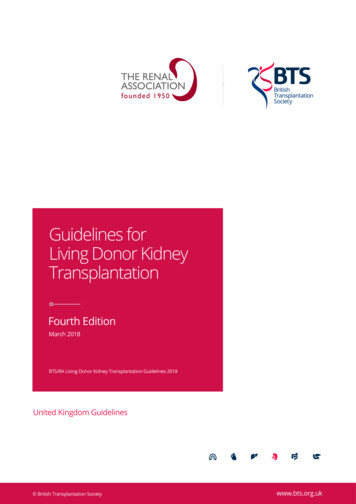
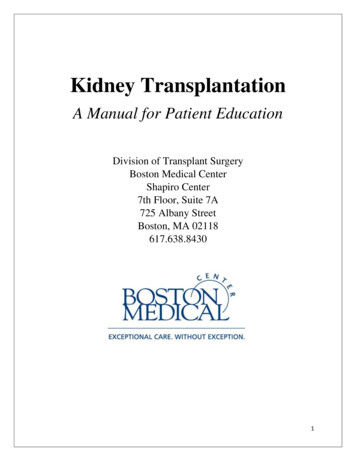
![OPTN Policies Effective as of April 28 2022 [9.9A]](/img/32/optn-policies.jpg)

